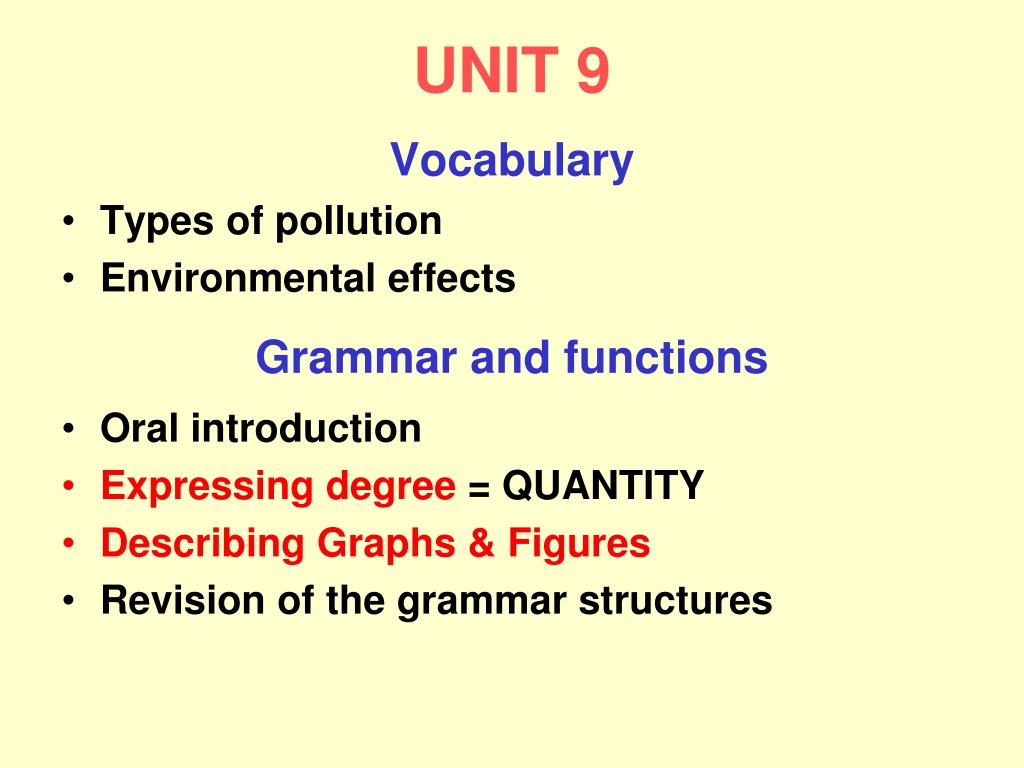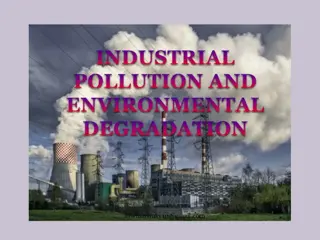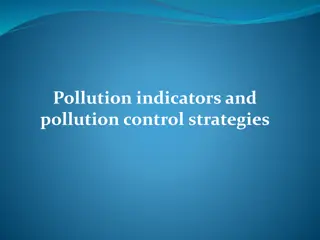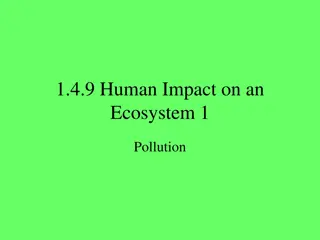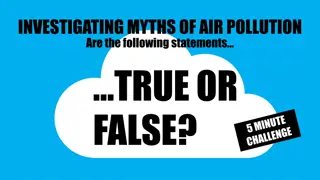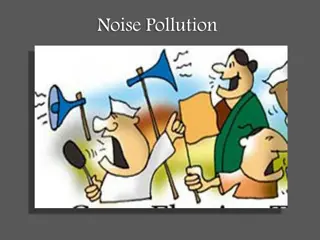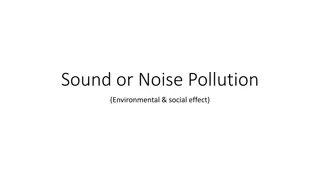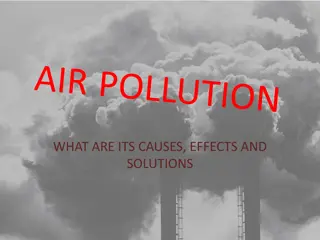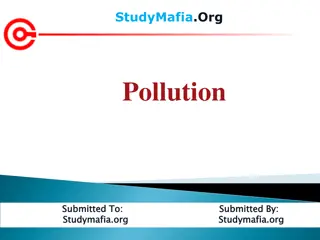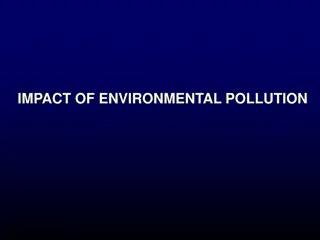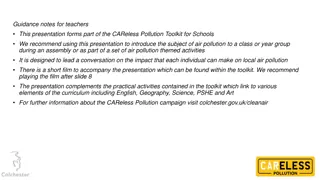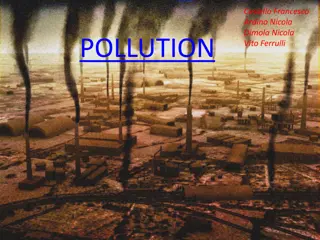Understanding Pollution: Types, Effects, and Solutions
Explore the various types of pollution, the environmental effects caused by human activities, and learn about expressing quantity and degree in this comprehensive unit. Discover how pollution contaminates the air, land, and water, and the importance of conservation efforts and new technologies in reducing pollutants. Additionally, gain insights into the impact of pollution on global warming and delve into exercises focusing on degree and grammar structures.
Uploaded on Sep 22, 2024 | 0 Views
Download Presentation

Please find below an Image/Link to download the presentation.
The content on the website is provided AS IS for your information and personal use only. It may not be sold, licensed, or shared on other websites without obtaining consent from the author. Download presentation by click this link. If you encounter any issues during the download, it is possible that the publisher has removed the file from their server.
E N D
Presentation Transcript
UNIT 9 Vocabulary Types of pollution Environmental effects Grammar and functions Oral introduction Expressing degree = QUANTITY Describing Graphs & Figures Revision of the grammar structures
LISTENING (p105) 1-Environmental pollution is the CONTAMINATION OF THE AIR, LAND AND WATER CAUSED BY HUMAN PRODUCTS. 2-a) CHEMICALS RELEASED BY INDUSTRIAL PROCESSES b) EXHAUST FROM GASOLINE-POWERED VEHICLES LIKE AUTOMOBILES, c) REFUSE AND GASES EMITTED BY FACTORIES, d) sewage and GARBAGE DISPOSED OF BY CITIES, e) PESTICIDES USED IN AGRICULTURE. 3- THE AMOUNT OF RELEASED POLLUTANTS. 4- a) CONSERVATION EFFORTS, SUCH AS RECYCLING b) NEW TECHNOLOGIES ALLOW INDUSTRY TO RELEASE FEWER POLLUTANTS INTO THE ENVIRONMENT. 5- The long-term effects of pollution are not yet PRECISELY known, but it is WIDELY believed by scientists that GLOBAL WARMING - THE HEATING OF THE EARTH S ATMOSPHERE AS A RESULT OF THE GREENHOUSE EFFECT is a threat to most forms of life on the planet .
ADJ/ADV p108 Quantity (+N): all/every/each | most|many/much (as much as)| a large amount/number|some, several, certain | (a) few/(a) little / a small amount/number I no (+N) /none (PRONOUN)/not any Certainty (+VB): certain(ly), absolute(ly)| probable(ly), (be) likely to(+INF)| possible(ly)| Uncertain(ly), (be) unlikely to I certain(ly) not, definite(ly) not Degree (Adj +N/Adv+VB/Adj):very + ADJ/ MUCH (+comp) significant(ly), substantial(ly), dramatically, widely (used) I mostly, greatly, highly, too (+ADJ), (ADJ)enough (N), rather, fairly, quite I slightly, hardly, scarcely Frequency (+VB): always| usual(ly), normal(ly), general(ly)| often, frequent(ly)| sometimes| rare(ly), seldom, hardly/ scarcely ever| never New sites for wind farms are likely to be mostly offshore Global carbon emissions have significantly increased in the last years
EXERCISE DEGREE A p108 1 We installed a complete new system We installed a completely new system 2 It was a really enjoyable film It was a real enjoyable film 3 The product is full guaranteed for a year The product is fully guaranteed for a year 4 The new car was a closely guarded secret The new car was a close guarded secret 5 He's a highly paid executive He's a high paid executive
EXERCISE DEGREE B p 109 1. Plant and animal life can be greatly affected by global warming 2. He's a highly qualified engineer 3. It was a badly written report and it needed a lot of corrections 4. He presented a well structured report 5. Supercharger engines achieve extremely high performance 6. Lignite s energy content is rather low 7. Wind power is likely to be the most widely used renewable energy source in the future 8. Stacked solar cells significantly increase the efficiency of solar cells 9. With a better control of CO2 emissions global warming would never have increased 10. Simply throwing trash into the recycling bin hardly does anything to reduce rubbish
READING : GLOBAL WARMING p 109 Which two environmental phenomena are caused by burning coal? What do the cumbustion gases do? What are the consequences of global warming? Do all scientists agree in their estimations? Which is the problem of deforestation? What does the text say about oil? Which is one of the main causes of hydrocarbon emissions? UNDERLINE DEGREE ADJECTIVES/ADVERBS
QUANTITY extra activity Recycling rates rose from 14% in 2012 to nearly 18% in 2013 On average, 16% of the money spent on a product pays for the packaging (see Figure 2) 9 out of 10 people would recycle more if it were much easier In 2011 US generated 2.6 million tons of e-waste out of which only 12.6% was recycled as shown in the graph Due to much less demand for lithium, almost none of the lithium used in batteries is recycled Oil is a particularly harmful water pollutant. Even a small amount of oil can severely contaminate water bodies 7 Most renewable energy sources produce little global warming 8. Too much effort is placed on waste disposal, and too little on pollution 9. If many more greenhouse gases are released into the atmosphere these gases can trap large amounts of heat, causing temperatures to rise 10. Presently coal-fired power plants are the most widely used despite their harmful effects on 0 human health and the environment 11. Governments should take some steps in order to control the consumption of fossil fuels, otherwise they will be exhausted in a few years 1. 2. 3. 4. 5. 6.
VIDEO: TYPES OF POLLUTION p107 Air pollution: 1:45-2:20 1. Main causes: TOXIC GASES & EXHAUSTS THAT ARE LED OUT INTO THE AIR 2. Produced by : 1. INDUSTRIES 2. VOLCANOS 3. JET PLANES 4. AUTOMOBILES 5. FOREST FIRES 6. BURNING OF GARBAGE 3. Consequences: CONTAIN MANY HARMFUL GASES THAT CAUSE 1. DISEASES IN HUMAN BEINGS 2. DESTRUCTION OF VEGETATION 3. DAMAGE TO THE STRUCTURES ON EARTH 4. CAN ALSO FORM ACID RAIN
VIDEO: TYPES OF POLLUTION p107 Water pollution: 2:20-2:55 4. Main causes: EFFLUENTS LED INTO WATER BODIES FROM INDUSTRIES SEWAGE FROM TOWNS & CITIES WASHING CLOTHES & CATTLE IN WATER BODIES RESIDUES OF FERTILIZERS & PESTICIDES CARRIED INTO WATER BODIES DURING RAIN The list of pollutants can be quite long OIL SPILL IN THE OCEANS HARMS MARINE LIFE
VIDEO: TYPES OF POLLUTION p107 Land pollution: 2:55-4:22 1. Main sources: HEAPS OF SOLID WASTE FROM 1. HOUSES, CATTLE SHEDS, INDUSTRIES, AGRICULTURAL FIELDS 2. It includes: 1. HAZARDOUS WASTE 2. GLASS 3. FRUIT & VEGETABLE WASTE 4. DEAD BODIES OF ANIMALS 5. OLD CLOTHES, PAPER, PLASTIC BOTTLES, CANS 6. EXCRETA, CHEMICALS, WOOD PIECES 3. Consequences: 1. THE HEAPS OF SOLID WASTE PROVIDE BREEDING GROUND FOR GERMS 2. IN ADDITION TO SPOILING THE BEAUTY AND SURROUNDINGS THEY EMIT FOUL SMELL 4. Solutions: CONTROLLING LAND POLLUTION. WASTE DISPOSAL DONE CAREFULLY & SCIENTIFICALLY. IT DEPENDS ON THE KIND OF SOLID WASTE: 1. CONSTRUCTING MATERIAL IS BURIED IN LAND FILLS 2. PLASTIC, TIN CANS, METAL SCRAP, PAPER MUST BE RECYCLED 3. PLANT & HOUSEHOLD ORGANIC MATERIAL SHOULD BE TURNED INTO MANURE 4. BIOGAS CAN BE OBTAINED FROM BIODEGRADABLE WASTE 5. WASTE FROM HOSPITAL & NURSING HOMES SHOULD BE BURNT IN INCINERATORS
VIDEO: TYPES OF POLLUTION p107 Soil pollution: 4:20-4:57 Difference with air pollution: LOCALIZED PHENOMENON (AIR & WATER POLLUTION SPREADS TO LONG DISTANCES) 10. The two main reasons for soil pollution are: POLLUTANTS WASHED DOWN FROM THE ATMOSPHERE BECAUSE OF RAIN INSECTICIDES AND PESTICIDES APPLIED TO THE CROPS THIS ALTERS THE COMPOSITION AND QUALITY OF THE SOIL Noise pollution: 4:57-6:00 11. What is noise?: ANY UNWANTED SOUND 12. Unit of measurement: DECIBEL (DB) 13. Examples: THE LOWEST SOUND = 1 db, A ROCKET TAKING OFF = 180 db. NORMAL TALK= 60db 14. Consequences: PRODUCE ADVERSE EFFECTS ON HUMAN BEINGS & OTHER ANIMAL LIFE 15. Which two aspects of noise are injurious for health? LOUDNESS and DURATION OF NOISE 16. Other consequences: ACUTE DAMAGE TO THE EAR DRUM, DEAFNESS, LOWERS EFFICIENCY OF WORK, DISTURBS SLEEP, IRRABILITY Thermal pollution: 6:00-6:25 17. What is thermal pollution?: RELEASE OF HEATED GASES OR WATER REPEATEDLY INTO THE ENVIRONMENT, INCLUDING WATER BODIES 18. Consequences: IF RELEASED IN THE ATMOSPHERE THEY WARM UP THE AIR IN THAT AREA IF RELEASED IN WATER BODIES THEY KILL THE AQUATIC LIFE 9.
TRANSLATION p106 Industrial and domestic pollution HAVE/HAS RISEN/INCREASED IN THE LAST 50 YEARS. Industrial air pollution includes the so-called greenhouse gases , LIKE/SUCH AS CARBON DIOXIDE and CFCs . BESIDES/IN ADDITION TO THESE GASES, we must not forget sulphur dioxide and nitrogen oxides, WHICH RESULT IN/GIVE RISE TO ACID RAIN. The largest single cause of industrial air pollution is the electricity industry, AS/SINCE ALL FOSSIL FUELS PRODUCE, AT LEAST, CARBON DIOXIDE. NEW TECHNOLOGIES ARE BEING APPLIED in a few places in order to minimize the effect of dangerous gas emissions, but these technologies are still very expensive and WOULD MAKE/CAUSE THE PRICE OF ELECTRICITY /TO RISE/INCREASE .
TRANSLATION p106 Two important causes of water pollution are ACID RAIN AND THERMAL POLLUTION. Land pollution is also an environmental THREAT IT ALSO TAKES PLACE/HAPPENS/OCCURS WHEN THE INDUSTRIAL WASTE is buried or .. Usually, but, AS WE HAVE SEEN, , and UNLESS WE CONTRIBUTE to reduce global pollution AS MUCH AS WE CAN.
GRAPHS & FIGURES (p112) As can be seen/ As shown IN THE TABLE/ GRAPH As can be seen / As shown IN Table/Graph 2 UP: RISE / RAISE / INCREASE / GROW /CLIMB /GO UP DOWN: DECREASE / DROP / FALL / DECLINE/ GO DOWN Typically N & Vb are modified by DEGREE ADJ/ADV ( e.g. a sharp increase / increased sharply) PREPOSITIONS: - Figures: BY(about) 10% /FROM (UP)TO 10%/ACCOUNT FOR 10% - Time: OVER a period / FROM TO / DURING/ SINCE (1994)/ FOR a long time - With NOUNS : Rise / increase / growth / drop / change / decline / decrease + IN value
LISTENING: GREENHOUSE EFFECT (p110) A greenhouse is a building whose sides and roof are made of glass so that the temperature inside is magnified. And it is used to grow plants that need high temperatures I mention this to illustrate an example of how man could be causing changes to the climate. These changes result from increasing the carbon dioxide levels in the atmosphere, thus raising the surface temperature of the earth. And this could alter what is known as the Greenhouse Effect . Let s start with carbon dioxide CO2. CO2 is a normal component of the atmosphere, and until recently has not been considered an air pollutant. But average global CO2 concentrations have been increasing since 1860, with a particularly sharp increase since 1958. As you see, it is a J curve. The main reason for this continuous increase in CO2 build-up is the burning of fossil fuels. You ll note that during the past 100 years, the CO2 content of the atmosphere has already risen by about 15% -from about 290 to about 340 parts per million. And it is still rising.
LISTENING: GREENHOUSE EFFECT 7. incoming sunlight consists of many wavelengths, including some very dangerous ones. 8. But ozone, water vapour and CO2 destroy the harmful wavelengths. So what reaches the earth is visible light. It is absorbed and reradiated into the atmosphere as longer wavelength infrared (IR) radiation, or heat, as the earth cools. 9. This IR radiation is absorbed by CO2. 10. The CO2 then radiates a portion of the absorbed heat energy back to the earth, to warm the atmosphere. 11. Like the glass in a greenhouse, the CO2 in the atmosphere acts as a one-way filter that allows visible light to enter the Earth s atmosphere, but prevents longer wavelength heat radiation from leaving. 12. Assuming that energy is arriving from the sun at a constant rate, then as the level of CO2 increases, the average surface temperature of the Earth should rise. 13. in 1863, but it was taken as a serious matter in 1956. 14. a projected increase in CO2 to 375 parts per million in the year 2000 could cause the average air temperature to increase by about 0.5 C.
EXERCISE A: Describe trend DOWN UP Increase Climb Lift Rise Fall Decrease Drop Decline
EXERCISE B: US Electricity The two PIECHARTS ILLUSTRATE the production of electricity in the US BY SOURCE in 2003 and 2012. In general, COAL was the most important ., although nuclear power GREW in importance. In 2003, coal-powered stations were the main source of electricity, producing 46% of electricity, and this FIGURE increased TO 55% in 2012. The SECOND most important source was natural gas, with almost 25%. However, by 2012, this had DECLINED to just 12.3%. Hydroelectric power also declined OVER the same period, FROM 16% to less than 14%. BY CONTRAST nuclear energy gained in importance. It ROSE from just 1.4% of production in 2003 to almost 14% in 2012, a TEN FOLD increase. IN SUMMARY more electricity was produced from coal and nuclear energy, WHILE natural gas, hydroelectric power, and oil declined IN IMPORTANCE
VIDEO: HOUSING PRICES What is VERY SIGNIFICANT about in the four countries OVER THE DECADE is that the houses in Japan DECLINED SHARPLY IN VALUE, FALLING BY 40% This CONTRASTS VERY STRONGLY with Australia. The latter did see A MARGINAL DROP IN house prices FROM 2000 TO 2002 but the next two years experienced VERY STRONG GROWTH. After A STABLE PERIOD LASTING four years Australian house prices DOUBLED IN VALUE so that OVER THE WHOLE PERIOD house prices in Australia RECORDED GROWTH OF 120%
VIDEO: HOUSING PRICES SIMILARLY, the UK saw A CONSIDERABLE INCREASE From 2000 TO 2008 house prices MORE THAN DOUBLED but after that FELL SHARPLY Canada also stands IN SHARP CONTRAST because it is the only country where HOUSE PRICE GROWTH WAS REGULAR
VIDEO: HOUSING PRICES The table data shows that THE 120% CHANGE IN HOUSE PRICES in Australia . was FROM A QUARTER OF A MILLION DOLLARS TO MORE THAN HALF A MILLION DOLLARS However AVERAGE ANNUAL WAGES during that period ONLY INCREASED BY ABOUT 50% The effect of this is that in 2000 HOUSE PRICES EQUATED TO 570% while ten years later THAT FIGURE HAD CLIMBED CONSIDERABLY TO 780%
VIDEO ACID RAIN PARAGRAPH 1 1. Which is the common thing in some lakes of Europe? 2. What is happening to some forests in Central Europe? 3. Which percentage of forests is affected? 4. What is happening to the future of salmon and trout fishing in N & Sw? 5. How many lakes in Sweden are not capable of supporting fish? 6. Which is the cause? PARAGRAPH 2 1. Which substances contain sulphur? 2. When does this sulphur become sulphuric acid? 3. What happens to this sulphuric acid 4. Which are the consequences of it falling locally? 5. what happens to pollution produced in Britain? PARAGRAPH 3 1. What effects does it have? 2. For example in Scandinavia the fish were disappearing from the lakes why?. 3. That is, what?
VIDEO ACID RAIN PARAGRAPH 1 1. they are threatened by a huge ecological disaster 2. the great forests are now dead or dying 3. 30% 4. the future of salmon and trout fishing is threatened 5. More than 4,000 6. acid rain PARAGRAPH 2 1. All fossil fuels, that is coal, oil and gas contain sulphur 2. when these are burnt, such as in power stations or motor vehicles 3. This sulphuric acid goes up into the air with the exhaust fumes and sooner or later it must fall back to earth 4. people who live in, near power stations notice that their cars rust quickly or that their masonry gets worn away 5. It is transported as far as Scandinavia PARAGRAPH 3 1. it damages vehicles and buildings, but it also has serious ecological effects 2. this was due to the acidification of the lakes, 3. there was so much sulphuric acid in the rain that the lakes themselves became acid which killed the fish
VIDEO ACID RAIN PARAGRAPH 4 1. Apart from the fish, what other things does it affect? 2. In Czechoslovakia what happened in the 60 s ? 3. When was the phenomenon noticed in Germany? 4. What is the situation now? 5. Which is the main source of acid rain? 6. What is required in Japan and W Germany? 7. What do these mechanism do? 8. What is the solution in Britain? 9. Is that any real use? PARAGRAPH 5 1. Which fuel could make some difference? 2. What is another major source of acid rain? 3. What is possible with this type of fuel? 4. What do these mechanisms do? 5. When is this solution not possible? 6. Why? PARAGRAPH 6 1. Summarize this paragraph
VIDEO ACID RAIN PARAGRAPH 4 1. 2. Acid rain also affects trees In Czechoslovakia in the 60 s trees began to die and now there are large areas of former forest which consist of only dead trees in the late 70s many forest areas are dying and some are already dead electric power stations laws requiring their power stations to build filter installations prevent the acid getting out into the air that the chimneys be built taller so that the pollution is more distributed it improves our air in our cities but it distributes the pollution further afield, so that forests in Scandinavia get affected PARAGRAPH 5 the introduction of lead-free petrol motor vehicles it would be possible to build exhaust filters prevent the release of acid with lead in the petrol because it prevents the filter mechanism from working PARAGRAPH 6 some of the forests are already too badly affected to be saved, but there are a lot more forests which are slightly affected, and if action was taken now, then they perhaps could be saved. Our forests and lakes are more than just places for relaxation and leisure. They are an essential part of the ecological balance which keeps our planet alive. If the problem is not faced very soon, it may be too late 3. 4. 5. 6. 7. 8. 9. 1. 2. 3. 4. 5. 6.
